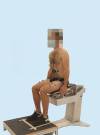Hip and trunk kinematics during reaching on a mobile and stable seat
- PMID: 37498910
- PMCID: PMC10374116
- DOI: 10.1371/journal.pone.0289115
Hip and trunk kinematics during reaching on a mobile and stable seat
Abstract
Reaching movements are often used to assess selective trunk control in people with neurological conditions. Also, it is known that reaching performance after stroke is increased through training on a mobile seat compared to conventional physical therapy. However, the effect of a mobile seat on joint kinematics has not yet been investigated. This study aimed to quantify differences in the range of motion of the hip and trunk during reaching exercises on a mobile and stable sitting surface. Fifteen healthy participants performed reaching beyond arm's length on a mobile and a stable seat in four different directions: ipsilateral, anterior, contralateral, and contralateral diagonal. Biomechanical data were collected, including kinematics of the hip and trunk, and surface electromyography of the trunk muscles. The mobile sitting surface led to a higher range of motion in the trunk and the hip in the frontal and sagittal plane, but not in the rotational plane. Differences between reaching directions were found in all joint directions, except that of trunk flexion. Hence, movement patterns of the hip and trunk differ during reaching on different sitting surfaces and in different directions. A larger range of motion in the frontal or sagittal plane while training on the mobile seat provides added neuromuscular stimuli to the trunk muscles (= a higher demand on trunk muscles), which could result in more efficient training and therefore, increased trunk control after stroke. However, this has to be investigated in a future study with people after stroke.
Copyright: © 2023 Haas et al. This is an open access article distributed under the terms of the Creative Commons Attribution License, which permits unrestricted use, distribution, and reproduction in any medium, provided the original author and source are credited.
Conflict of interest statement
Daniel Baumgartner is the owner of rotavis AG (Winterthur, Switzerland), the company that implements the mobile seat system. This does not alter our adherence to PLOS ONE policies on sharing data and materials. All other authors have declared that no competing interests exist.
Figures





Similar articles
-
Surface electromyographic activity of trunk muscles during trunk control exercises for people after stroke; effect of a mobile and stable seat for rehabilitation.PLoS One. 2022 Jul 29;17(7):e0272382. doi: 10.1371/journal.pone.0272382. eCollection 2022. PLoS One. 2022. PMID: 35905083 Free PMC article.
-
The Effect on Muscle Activity of Reaching Beyond Arm's Length on a Mobile Seat: A Pilot Study for Trunk Control Training for People After Stroke.Arch Rehabil Res Clin Transl. 2023 Aug 7;5(4):100289. doi: 10.1016/j.arrct.2023.100289. eCollection 2023 Dec. Arch Rehabil Res Clin Transl. 2023. PMID: 38163026 Free PMC article.
-
Arm and trunk movement kinematics during seated reaching within and beyond arm's length in people with stroke: a validity study.Phys Ther. 2014 Jun;94(6):845-56. doi: 10.2522/ptj.20130101. Epub 2014 Jan 30. Phys Ther. 2014. PMID: 24481598
-
Kinematic Manifestation of Arm-Trunk Performance during Symmetric Bilateral Reaching After Stroke: Within vs. Beyond Arm's Length.Am J Phys Med Rehabil. 2017 Mar;96(3):146-151. doi: 10.1097/PHM.0000000000000554. Am J Phys Med Rehabil. 2017. PMID: 27386806
-
Compensatory Versus Noncompensatory Shoulder Movements Used for Reaching in Stroke.Neurorehabil Neural Repair. 2016 Aug;30(7):635-46. doi: 10.1177/1545968315613863. Epub 2015 Oct 27. Neurorehabil Neural Repair. 2016. PMID: 26510934
Cited by
-
Effects of Support Surface and Shooting Action on Muscle Activity of Trunk Muscles in Ice Hockey Players: A Cross-Sectional Study.J Clin Med. 2025 Mar 19;14(6):2090. doi: 10.3390/jcm14062090. J Clin Med. 2025. PMID: 40142898 Free PMC article.
References
MeSH terms
LinkOut - more resources
Full Text Sources
Medical

